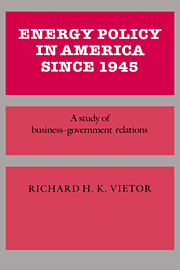Book contents
- Frontmatter
- Contents
- List of charts and figures
- List of tables
- Editors' preface
- Acknowledgments
- List of abbreviations
- 1 Introduction: The political economy of energy
- Part I The transition to peace and fluid fuels, 1945–1958
- 2 The foundations of postwar policy
- 3 “Stepping right out” with synthetic fuels
- 4 Regulating natural gas in the absence of economics
- 5 Oil imports: the failure of voluntarism
- Part II Managing surplus through the politics of stasis, 1959–1968
- Part III The second energy transition: adjustment to depletion, 1969–1980
- Index
5 - Oil imports: the failure of voluntarism
Published online by Cambridge University Press: 13 October 2009
- Frontmatter
- Contents
- List of charts and figures
- List of tables
- Editors' preface
- Acknowledgments
- List of abbreviations
- 1 Introduction: The political economy of energy
- Part I The transition to peace and fluid fuels, 1945–1958
- 2 The foundations of postwar policy
- 3 “Stepping right out” with synthetic fuels
- 4 Regulating natural gas in the absence of economics
- 5 Oil imports: the failure of voluntarism
- Part II Managing surplus through the politics of stasis, 1959–1968
- Part III The second energy transition: adjustment to depletion, 1969–1980
- Index
Summary
The postwar availability of foreign oil at nearly half the price of domestic supplies caused a major disruption to existing energy markets. Not only did it foreclose the potential market for synthetic fuels, but beginning in 1949, and for the next 20 years, it created a dilemma for the American political economy.
Since foreign oil was so much cheaper than domestic, it served the short-term interests of American consumers. Dependence on foreign oil, however, posed a problem for national security. In the long run, it could foster conservation of domestic reserves. But in the short-run event of geopolitical or military crisis, would domestic production capacity then be adequate? The perceived need for a U.S. presence in the Middle East and reasonable control of its oil resources by U.S. multinational firms confounded the dilemma. Since retention of their concessions depended on constantly increasing their output, those companies were invariably under pressure to increase deliveries of oil to the United States, the world's largest and fastest growing market.
As real as this dilemma was, it amounted to an allegory for a protracted conflict among interest groups that were competing for market share during a period of energy glut and declining prices.
- Type
- Chapter
- Information
- Energy Policy in America since 1945A Study of Business-Government Relations, pp. 91 - 116Publisher: Cambridge University PressPrint publication year: 1984



